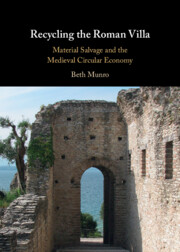Refine search
Actions for selected content:
87 results
The Economic Benefit of Recycling: An Application of Travel Cost Method to Estimate the Consumer Surplus
-
- Journal:
- Journal of Benefit-Cost Analysis , First View
- Published online by Cambridge University Press:
- 15 October 2025, pp. 1-14
-
- Article
-
- You have access
- Open access
- HTML
- Export citation
9 - Resource Use Efficiency and Pathways to Environmental Sustainability
- from Part II - Application Case Chapters
-
- Book:
- Cities and Environmental Change
- Published online:
- 15 August 2025
- Print publication:
- 28 August 2025, pp 190-214
-
- Chapter
- Export citation
Human–robot task distribution metrics in car battery recycling: a case study on screw removal
-
- Journal:
- Robotica , First View
- Published online by Cambridge University Press:
- 01 August 2025, pp. 1-21
-
- Article
- Export citation
10 - Minerals and Energy
- from Part III - Application to Environmental Sustainability
-
- Book:
- Economics for a Sustainable World
- Published online:
- 14 July 2025
- Print publication:
- 12 June 2025, pp 292-317
-
- Chapter
- Export citation
The Other Container Revolution: How Businesses Influenced Environmental Politics and Thus the Recycling of Beverage Containers
-
- Journal:
- Enterprise & Society , First View
- Published online by Cambridge University Press:
- 08 May 2025, pp. 1-33
-
- Article
-
- You have access
- Open access
- HTML
- Export citation
Introduction
-
- Book:
- Making Do
- Published online:
- 24 April 2025
- Print publication:
- 24 April 2025, pp 1-18
-
- Chapter
- Export citation
The Potential Impacts of Single-use Plastic During the COVID-19 Pandemic
-
- Journal:
- Disaster Medicine and Public Health Preparedness / Volume 19 / 2025
- Published online by Cambridge University Press:
- 31 January 2025, e19
-
- Article
- Export citation
Chapter 4 - The 1850s Sustainability Novel
-
-
- Book:
- Nineteenth-Century Literature in Transition: The 1850s
- Published online:
- 02 January 2025
- Print publication:
- 16 January 2025, pp 90-112
-
- Chapter
- Export citation
Chapter 4 - Recycling and Reembodying, Twining and Untwining
-
- Book:
- Embodied Experience in British and French Literature, 1778–1814
- Published online:
- 19 December 2024
- Print publication:
- 02 January 2025, pp 159-209
-
- Chapter
-
- You have access
- Open access
- HTML
- Export citation
Chapter 14 - Towards a 100% Renewable Electricity Supply
-
- Book:
- Wind Turbines
- Published online:
- 24 January 2025
- Print publication:
- 19 December 2024, pp 390-409
-
- Chapter
- Export citation
Bridging the intergenerational gap: boosting recycling behavior and policy support through eliciting concerns for future others
-
- Journal:
- Behavioural Public Policy , First View
- Published online by Cambridge University Press:
- 10 December 2024, pp. 1-22
-
- Article
-
- You have access
- Open access
- HTML
- Export citation
8 - Border Frictions
- from Part II - Pathways and Predicaments
-
- Book:
- Polluted Politics
- Published online:
- 18 December 2024
- Print publication:
- 05 December 2024, pp 181-204
-
- Chapter
- Export citation
Pioneering the Circular Economy: Small and Medium-Sized Recycling Enterprises in Finland, 1945–1995
-
- Journal:
- Business History Review / Volume 98 / Issue 4 / Winter 2024
- Published online by Cambridge University Press:
- 14 April 2025, pp. 793-819
- Print publication:
- Winter 2024
-
- Article
- Export citation

Recycling the Roman Villa
- Material Salvage and the Medieval Circular Economy
-
- Published online:
- 08 November 2024
- Print publication:
- 31 October 2024
Edcraft: Gamified Handicrafts as an Inspiration for Teenagers to Practice Upcycling
-
- Journal:
- Australian Journal of Environmental Education / Volume 40 / Issue 4 / August 2024
- Published online by Cambridge University Press:
- 01 October 2024, pp. 758-769
-
- Article
-
- You have access
- Open access
- HTML
- Export citation
Ceramic Membranes Prepared from a Silicate and Clay-mineral Mixture for Treatment of Oily Wastewater
-
- Journal:
- Clays and Clay Minerals / Volume 63 / Issue 3 / June 2015
- Published online by Cambridge University Press:
- 01 January 2024, pp. 222-234
-
- Article
- Export citation
Chapter 11 - Evaluating and Communicating Information
- from Part II - Engaging in Disciplinary Tasks in Science and Engineering
-
- Book:
- A Practical Approach to Supporting Science and Engineering Students with Self-Regulated Learning
- Published online:
- 02 November 2023
- Print publication:
- 16 November 2023, pp 185-206
-
- Chapter
- Export citation
Waste Nothing: The Impact of Glass and Metal Recycling in Imperial Roman Towns
-
- Journal:
- European Journal of Archaeology / Volume 26 / Issue 4 / November 2023
- Published online by Cambridge University Press:
- 04 August 2023, pp. 467-485
-
- Article
- Export citation
Global plastic pollution and informal waste pickers
-
- Journal:
- Cambridge Prisms: Plastics / Volume 1 / 2023
- Published online by Cambridge University Press:
- 21 June 2023, e9
-
- Article
-
- You have access
- Open access
- HTML
- Export citation
CREATING AN OPEN-SOURCE, LOW-COST COMPOSITE FEEDER DESIGN TO IMPROVE FILAMENT QUALITY OF HIGH-PERFORMANCE MATERIALS TO BE USED IN FUSED FILAMENT FABRICATION (FFF)
-
- Journal:
- Proceedings of the Design Society / Volume 3 / July 2023
- Published online by Cambridge University Press:
- 19 June 2023, pp. 1097-1106
-
- Article
-
- You have access
- Open access
- Export citation
